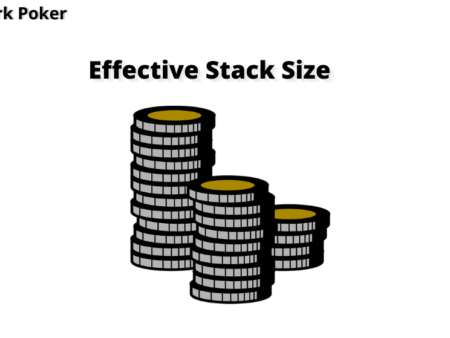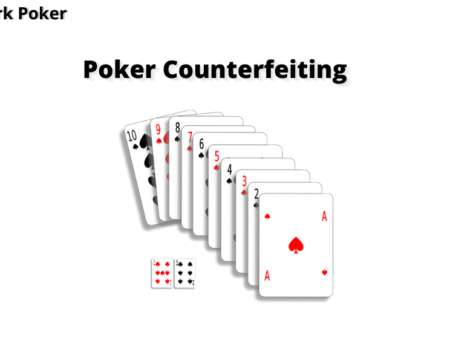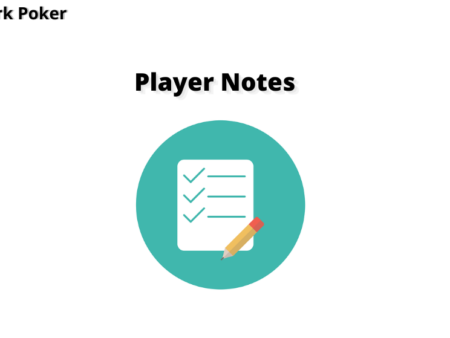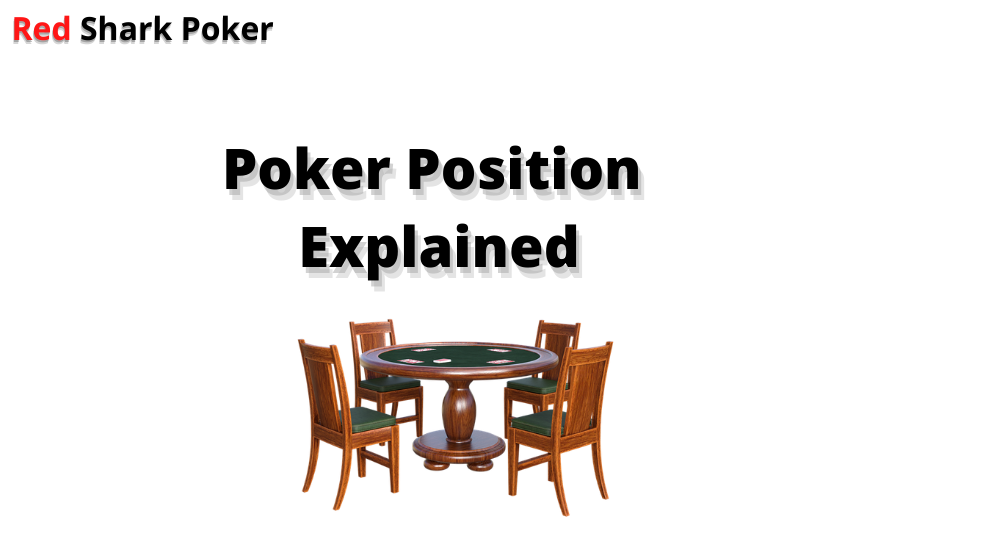
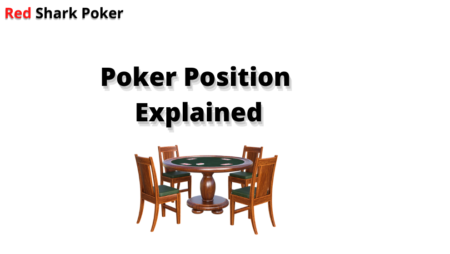
Poker Position, position, position! This is probably the most uttered word you will hear in a poker commentary. And why not? Poker position is the fundamental strategy that guides most of your decisions at the tables.
This article will introduce you to what position means in poker. Once you learn about poker table positions and its importance, you might want to rename the game of poker as “a game of positions”.
But first, let us understand the importance of position in real life
Imagine your boss calling your management team to an emergency meeting to discuss the sudden drop in sales. The management team comprises of four members.
In the conference room, your angry boss asks, “Who has any idea about the sudden drop in sales?”
This is a tense situation, but the question is – who is going to speak first?
It is usually the person who has the right information. If you don’t have the right information and speak, you will look like a fool and invite the wrath of your boss.
Nobody answers. Your irritated boss says, “Alright, everyone will talk about the possible reasons one by one, starting from the person to my left.”
Now the person to the left of your boss is in a tough spot as he will be the first one to speak. You can say that he is seated in an early position at the table. He doesn’t have any information and replies, “Sorry, I don’t know the reason.”
The second colleague to the left is in a middle position at the table. He says that the marketing team was planning on running a new sales campaign yesterday evening.
The third colleague to the left is also in a middle position at the table. She says that the tech team made some changes on the sales website last night.
Now, you are the last person to speak; so, you are in a late position at the table. The only information you have is that the Quality Assurance (QA) Lead is on leave. But you have gathered all the information from your colleagues and merged them together with your piece of information to solve the puzzle.
You reply that the marketing team probably ran a last-minute campaign last night and the tech team implemented it on the website. As the QA Lead was on leave, the changes were made live on the website without a proper quality check, and this might have crashed the online payment section. So, we have a drop in sales. Puzzle solved! And your boss was quite impressed.
What do we learn from this hypothetical scenario? Position matters! As you were the last person to speak or seated in a late position, you gathered all the information to solve the puzzle and even scored some brownie points.

Similarly, poker tables positions matter a lot – The later, the better. Poker is a game of information. The more information you gather, the better are your decisions.
What are the poker table positions?
There are three main positions at a poker table: Early Position, Middle Position and Late Position.
How to find out any position? Just look at the Dealer button on the table. The player who has the Dealer button is said to be “On the Button”. The players seated to the left of the Button are in early positions. The players seated to the right of the Button, including the player on the button, are in late positions.
Players to the Left of the Button = Early Positions
Players to the Right of the Button = Late Positions
9-max Poker Positions
Let’s look at the poker position chart below:
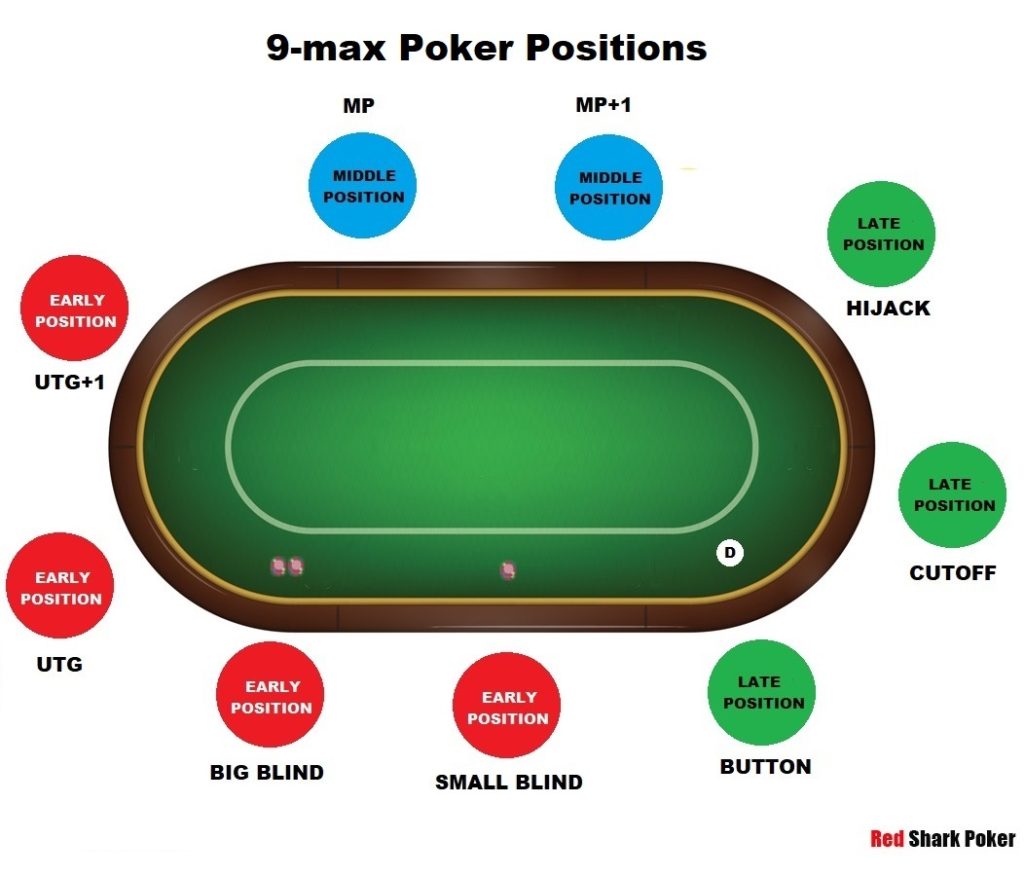
Early Poker Positions: The four players seated to the left of the Button are in early positions.
- Small Blind: The small blind is seated directly to the left of the dealer. He may not be the first to act on the preflop but will be the first to act post-flop. This is why the small blind is in an early position.
- Big Blind: The big blind acts last on preflop, but he will be the second person to act post-flop. That is why the blinds are considered to be in early positions.
- Under the Gun (UTG): The player seated to the left of Big Blind is playing from Under the Gun position. He is the first person to act during preflop; this is why he is in an early position.
- Under the Gun + 1 (UTG+1): The player seated to the left of UTG is UTG+1. He is the second person to act during preflop. Thus, he is also in an early position.
Middle Poker Positions: The two players seated to the left of UTG+1 are in middle positions.
- Middle Position (MP): The player seated to the left of UTG+1 is the Middle Position (MP).
- Middle Position + 1 (MP+1): The player seated to the left of MP is the Middle Position + 1 (MP+1).
Late Poker Positions: The three players seated to the left of MP+1 are in late positions.
- Hijack (HJ): The player to the left of MP+1 is called Hijack.
- Cutoff (CT): The player to the left of Hijack is called Cutoff.
- Button (BTN): The last player, who has the Dealer button, is on the Button. He is the last person to act post-flop. This is the best position in poker.
6-max Poker Positions
Let’s look at the poker position chart below:
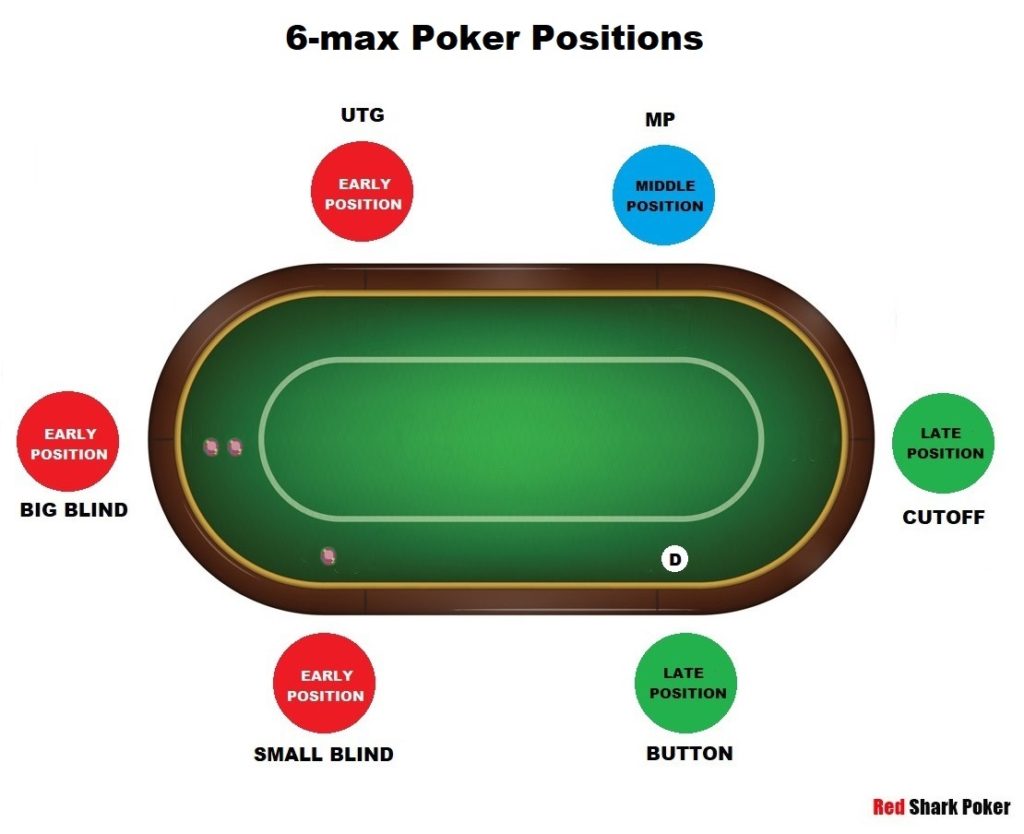
As 6-max games have three players less than full ring games, you don’t have UTG+1, MP+1 and Hijack.
Early Positions: The big blind, the small blind and the UTG are in early positions in 6-max games. UTG is the first person to act preflop, and the blinds will act first post-flop.
Middle Position: The player seated to the left of UTG is in a middle poker position.
Late Position: The Cutoff and the Button are in late poker positions.
Starting Hand Selection According to Poker Positions
This is where Texas Holdem positions matter the most! You need to choose your starting hand ranges according to your position. Follow this time-tested poker strategy for starting hand selection:
Earlier the Position = Stronger Hands to Play
This poker position strategy is based on a simple logic: If you are in an early position, you will be the first person to act. So, your hands have to be stronger than your opponents who are in later positions. If you play with a weak hand, there is a possibility that your opponents in late positions might be holding a stronger hand. Your winning chances will decrease, and you might lose a lot of money.
So, what are the best hands to play according to your poker seat positions?
As mentioned before, early positions should play with a tight range of hands. Later positions can play with a wider range of hands as they can gather a lot of information from other players.
Early Poker Position Hand Ranges
If you are a beginner, you should play with the top 10% of hands from early positions. The hands include pairs like 66 and above, AT suited and above, AQ off-suit and above, etc. You can refer to the starting hand chart below.
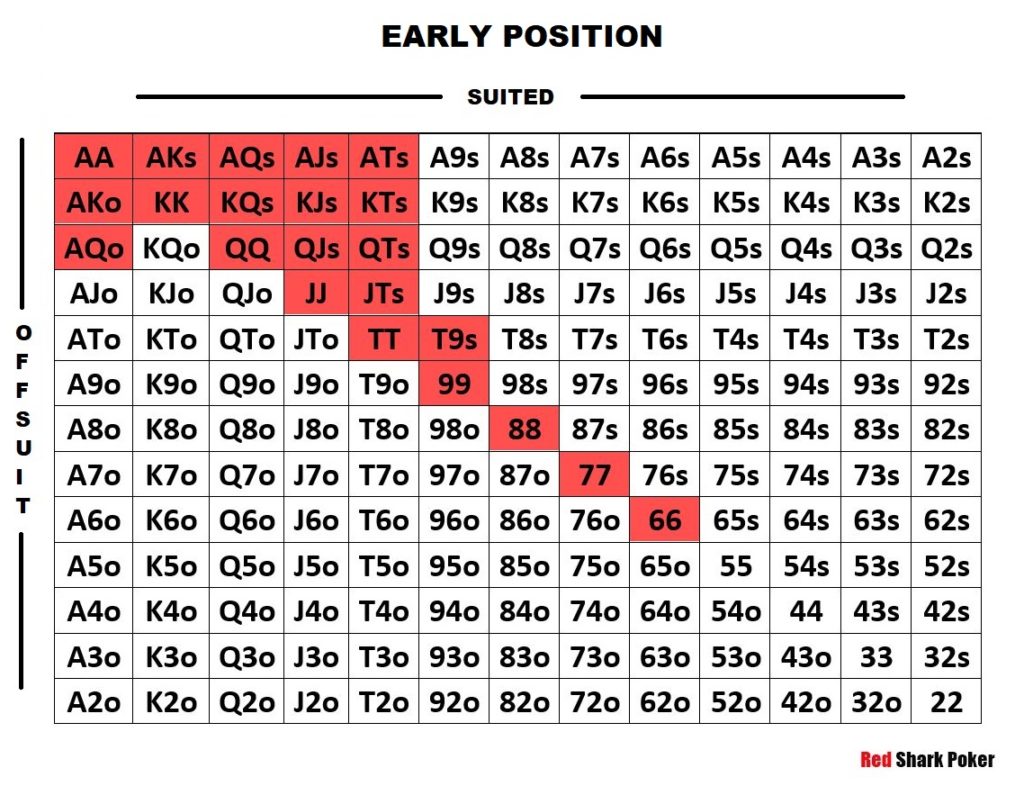
Note: You can adjust your hand range according to your playing style.
Middle Poker Position Hand Ranges
You should play with the top 19% of hands from middle positions. When you are in a middle position, you can make your range wider by including pairs like 33 and above, all ace suited, AT off-suit and above, suited connectors like 87 and above, etc. You can refer to the starting hand chart below.
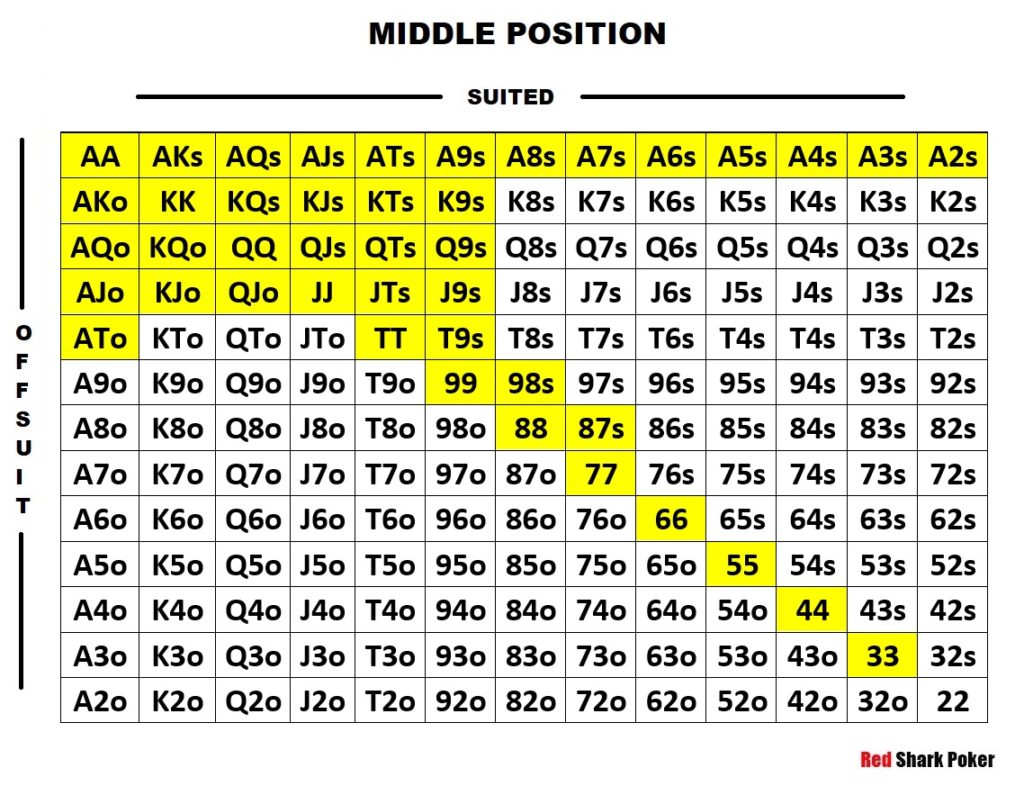
Note: You can adjust your hand range according to your playing style.
Late Poker Position Hand Ranges
You can play with the top 45% of hands from late positions. When you are in a late position, you will have the added advantage of analyzing your opponents’ actions before making your move. You can bluff often and connect more cards with the board. Your range includes all pairs, all ace suited, all king suited, all queen suited, suited connectors, suited gappers, etc. You can refer to the starting hand chart below.
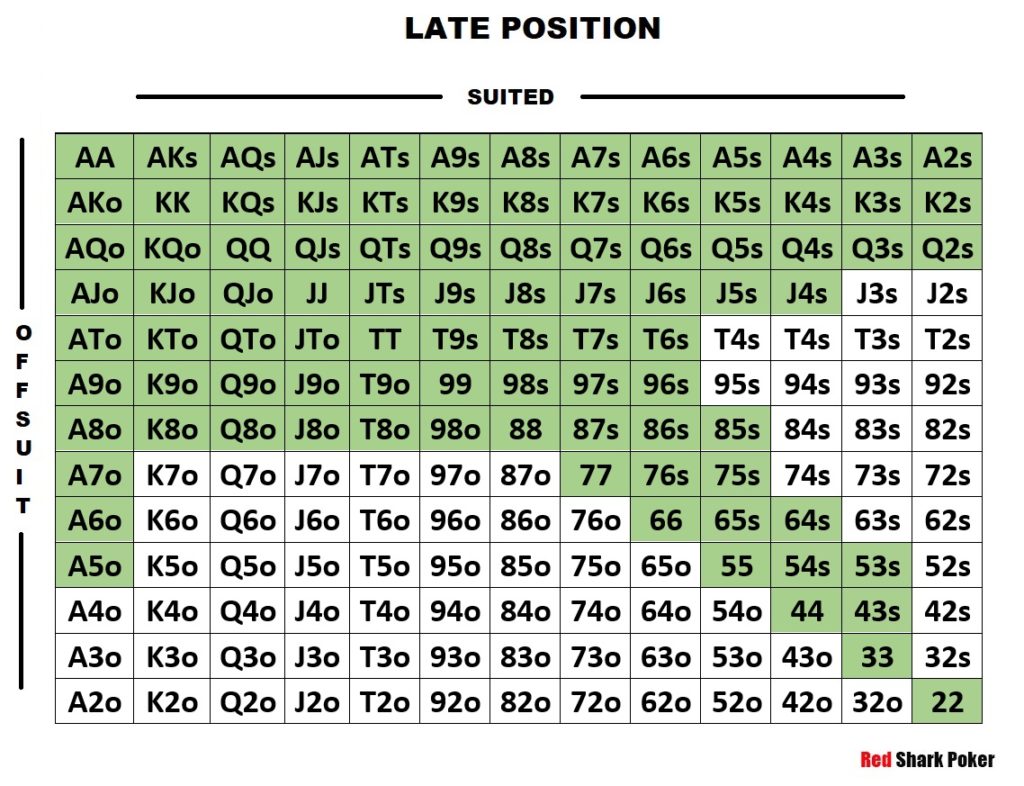
Note: You can adjust your hand range according to your playing style.
Basic Poker Position Strategies
There are literally thousands of strategies on poker positions. Since this article is an introduction to position, we will be talking about the basic poker position strategies.
Use Your Position to Bluff
With the help of your position, you can bluff your opponent easily. This applies to both early and late positions. Let’s look at some examples.
Bluffing from Late Poker Position: A player from UTG (early position) raises to 3X Big Blind (bb), and you are on the Button (late position) with 5♦ 6♦ decide to call. Everyone else folds.
The flop comes 7♣ 2♥ 10♠. The villain (opponent) checks. You also check.
The turn comes 7♣ 2♥ 10♠ 7♥. The villain checks again. Here, you can use your position to your advantage. Raising from UTG requires a strong hand like AA, KK, AK, broadway hands (10 to Ace) or strong connectors. It is quite improbable for your opponent to have a 7 in his range. As you are on the Button, a 7 can be within your range. So, here you can easily represent a Three of a Kind. You make a full pot bet, and the villain makes a quick fold.
Bluffing from Early Poker Position: It is also possible to bluff from early position. You raise to 3X bb with A♠ Q♠ from UTG. The Button calls, and everyone else folds.
The flop comes K♣ 2♥ K♠. Here, you can represent a Three of a Kind as a King is well within your early position hand range. You make a full pot bet, and the villain makes a quick fold.
So, use your position to represent a hand from your starting hand range for bluffing.
Use Your Position to Extract Information
If you are unsure of your opponent’s hand range, you can use your position and bet to get information. Let’s look at an example.
A player from UTG (early position) raises to 3X bb. You are on the Button (late position) with Q♦ 10♦ call. Everyone else folds.
The flop comes K♣ Q♥ 2♠. The villain checks. You have a pair and make a half-pot bet. The villain calls.
The flop comes K♣ Q♥ 2♠ K♦. The villain now checks. You have a pair of queens, but you are unsure of what the villain has. Is he setting a trap with trips? Or does he have AJ or A10 waiting to complete his straight draw? In such a situation, you can use your position to bet and extract information. If you make a small bet of 1/4 pot and he calls or raises, he definitely has something. Or else, he will fold.
In this way, you have used your late position to extract this vital information.
Conclusion
Always spot the Dealer button to know your position. Use the starting hand range chart and assess your position. Enter the pot only if you think you have a hand that justifies your position. If you have just started to play poker, we advise you to play mostly from late positions, which is also called “In Position”. Play from early position (Out of Position) with only strong hands. Once you get used to playing from in and out of positions, check out our other poker position strategies to learn more ways on capitalizing on positions. Till then, keep practising!
Also Read: Learn the Right Way to Cbet in Poker
If you have any questions, feel free to comment below. We will be happy to answer!

